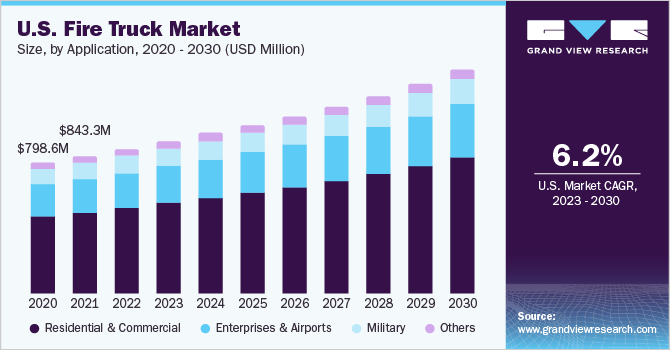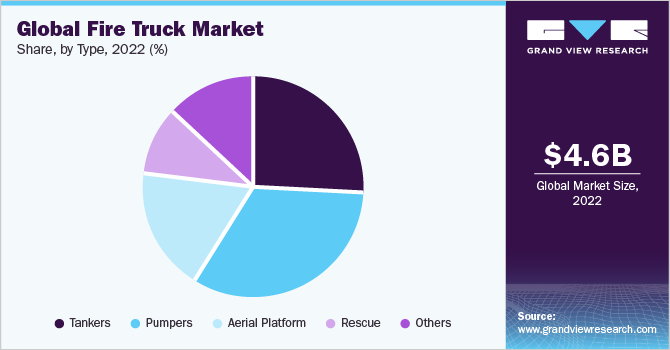- Home
- »
- HVAC & Construction
- »
-
Fire Truck Market Size, Share, Growth, Industry Report 2030GVR Report cover
![Fire Truck Market Size, Share & Trends Report]()
Fire Truck Market Size, Share & Trends Analysis Report By Application (Residential & Commercial, Enterprise & Airports, Military, Others), By Type (Tankers, Pumpers, Aerial Platform, Rescue, Others), By Region, And Segment Forecasts, 2023 - 2030
- Report ID: GVR-1-68038-299-0
- Number of Report Pages: 189
- Format: PDF, Horizon Databook
- Historical Range: 2018 - 2021
- Forecast Period: 2023 - 2030
- Industry: Technology
Fire Truck Market Size & Trends
The global fire truck market size was valued at USD 4,631.1 million in 2022 and is anticipated to grow at a compound annual growth rate (CAGR) of 5.6% from 2023 to 2030. The necessity for advanced firefighting equipment and the rising demand for fire safety in developed nations are anticipated to boost the market expansion for fire trucks. A substantial increase in demand for fire safety among developed countries and the need for advanced firefighting equipment are factors expected to augment the market growth. Furthermore, improving standards concerning safety across the globe are expected to aid the demand for advanced fire trucks in the coming years.

The outbreak of COVID-19 negatively impacted the market globally. Because of the stoppage of transit and international trade, makers of firefighting vehicles had to deal with some supply chain challenges. However, the industry started to pick up steam in the subsequent months, and throughout the projected period, it is anticipated that the demand for firefighting vehicles will increase significantly. The development of electric trucks and the rising popularity of firefighting equipment and local assemblies are projected to have a beneficial impact on the market for fire trucks.
The noticeable increase in demand for fire trucks can be attributed to factors such as new infrastructure development and an increase in fire incidents in residential and commercial spaces, as well as sanctuaries and wildlife areas. For instance, in 2021, the U.S. witnessed around 8,619 wildfires that destroyed 2.6 million acres of land as well as close to 3,629 structures, while it also involved extensive loss of human life.
One of the biggest markets for fire trucks is China due to the growing economy and rapid urbanization, combined with strict codes and standards for the decrease in infrastructural damage and loss that have created a need for fire trucks and emergency equipment. As China continues to build its civil aviation airport infrastructure, the need for fire and safety equipment keeps rising. The country built 43 airports between 2016 and 2020 and close to 6 new airports in 2021, bringing the number of airports operating in the country to 247.
Furthermore, the departments need to keep upgrading their equipment and apparatus owing to the constant technological advancements in the sector. As a result, frequent amendments are made to the guidelines and regulations enforced by associations such as the National Fire Protection Association (NFPA) in the U.S. and the National Association of Fire Equipment in India.
Infrastructural development in emerging countries has led regulatory bodies to enforce stringent codes and standards to decrease infrastructural damage and losses, which is expected to augment the industry’s growth. However, high preliminary costs and capital requirements for the manufacturing of trucks are expected to restrain the market growth to a certain extent over the forecast period.
Application Insights
The residential & commercial application segment accounted for the largest share in the global market for fire trucks and is expected to expand at a steady CAGR of 6.0% over the forecast period. The market growth in this segment is anticipated to augment on account of the rising global population, which in turn is expected to increase the demand for the construction of residential and commercial buildings.
The growing population and the resultant spike in building & construction activities worldwide have led to governments enforcing stringent fire safety regulations across several critical sectors, including residential, commercial, airports, and industries. This factor has resulted in a significant increase in the global consumption of fire trucks in residential & commercial applications.
The growing utilization of Aircraft Rescue Fire Fighting (ARFF) vehicles for airport safety and rescue operations is expected to drive the market demand in the enterprises & airports segment. This segment accounted for 24.1% of the total market share in terms of revenue in 2022. The presence of ARFF is anticipated to increase this segment’s market share, owing to the rapidly growing number of airports and air passenger traffic globally.
The continuously rising demand for advanced firefighting apparatus in developed countries such as the UK, France, and the U.S. is expected to augment the growth of the market in North America and Europe. On the other hand, the steadily increasing building & construction activities, coupled with low prices, are expected to drive market growth in China over the forecast period.
Type Insight
In 2022, the pumper segment accounted for the largest revenue share of 32.6% of the market. The popularity and product demand of pumper trucks will increase over the projection period due to their ability to pump water from outside sources such as water tankers, wells, and overhead tanks, as well as their lower cost when compared to other high-tech fire truck models. Based on type, the market for fire trucks is bifurcated into tankers, pumpers, aerial platforms, rescue, and others.

Several factors, including population growth, an increase in building and construction activities, and governments implementing stringent fire safety rules, have contributed to an increase in the demand for tankers in recent years. This trend is anticipated to continue further in the years to come.
Regional Insights
The global fire trucks industry is led by the Asia Pacific, with the region accounting for 29.1% of the revenue share in 2022, and is expected to continue its dominance throughout the forecast period. The presence of key low-cost manufacturers in China, coupled with the rising demand from residential & commercial applications in emerging economies such as China, South Korea, and India, majorly drive the fire truck market growth in the region.

China is one of the largest markets, both in terms of production as well as consumption. The high production capacity and supply are driven by the considerably low costs of production. In addition, the country is an industrial hub for several global manufacturers. Increased utilization of fire trucks is anticipated in applications such as commercial spaces, enterprises, and airports, owing to the aforementioned factors.
The North American market contributed to around 25.1% of the revenue share in 2022. The North American production value witnessed a significant increase that is primarily driven by the increased demand from the residential & commercial application segment. Furthermore, the growing requirement for advanced safety infrastructure in residential buildings, commercial complexes, and enterprises is expected to augment themarket demand for fire trucks.
Key Companies & Market Share Insights
The global market is very competitive due to the presence of many established manufacturers and suppliers. Major players such as Rosenbauer International AG, Oshkosh Corporation, Magirus GmbH, and Weihai Guangtai have adopted product innovations and numerous strategic alliances for strengthening their global positions, which are being followed by emerging industry players.
Along with expanding their company's size and reach, market players also concentrate on research and development activities to manufacture products with the latest technologies to compete in the market. For instance, in May 2022, Rosenbauer introduced the latest firefighter excavators for utilization in forest fires. The firefighter excavator is equipped with a variety of equipment to combat forest fires. It was developed in collaboration with CSM Industry.
Similarly, in June 2021, Oshkosh Corporation, including Oshkosh Airport Products, Frontline Communications, and Pierce Manufacturing, launched the revolutionary Volterra platform of electric vehicles in the fire and emergency segments. Airports all around the globe have prioritized green measures, compelling fire departments to look for environment-friendly fire apparatus that reduce fuel use, cut emissions, and emit less noise. Oshkosh has made Volterra keeping in mind these requirements. Some of the prominent players in the global fire truck market include:
-
Rosenbauer International AG
-
Oshkosh Corporation
-
Magirus GmbH
-
Weihai Guangtai
-
Danko Emergency Equipment Co.
-
E-One Inc.
-
Spartan Motors
-
Xuzhou Handler Special Vehicle Co. Ltd.
-
Zoomlion
-
Bronto Skylift Oy Ab
Recent Development
-
In April 2023, E-ONE introduced the new Defender Type III Urba n-Interface Pumper, built to stand strong for the most challenging situations. The design features low battery cell placement for better stability while operating.
-
In June 2022, Scania introduced a new hybrid solution for airport fire trucks. The new system allows more sustainable operations in and around airports and meets the strict aviation industry requirements.
-
In June 2022, Oshkosh Corporation acquired Maxi-Métal Inc. to expand sales and distribution capabilities of fire apparatus and utility vehicles within Canadian market.
-
In June 2021, Oshkosh Corporation introduced two new electric trucks to serve the airport fire & emergency market with new Volterra technology.
Fire Truck Market Report Scope
Report Attribute
Details
Market size value in 2023
USD 4,880.9 million
Revenue forecast in 2030
USD 7,163.7 million
Growth rate
CAGR of 5.6% from 2023 to 2030
Base year for estimation
2022
Historical data
2018 - 2021
Forecast period
2023 - 2030
Report updated
June 2023
Quantitative units
Revenue in USD million and CAGR from 2023 to 2030
Report coverage
Revenue forecast, company ranking, competitive landscape, growth factors, and trends
Segments covered
Application, type, region
Regional scope
North America; Europe; Asia Pacific; Latin America; MEA
Country scope
U.S.; Canada; UK; Germany; France; Italy; Spain; China; India; Japan; Australia; South Korea; Brazil; Mexico; Argentina; UAE; Saudi Arabia; South Africa
Key companies profiled
Rosenbauer International AG; Oshkosh Corporation; Magirus GmbH; Weihai Guangtai; Danko Emergency Equipment Co.; E-One Inc.; Spartan Motors; Xuzhou Handler Special Vehicle Co. Ltd.; Zoomlion; Bronto Skylift Oy Ab
Customization scope
Free report customization (equivalent to up to 8 analysts’ working days) with purchase. Addition or alteration to country, regional & segment scope.
Pricing and purchase options
Avail customized purchase options to meet your exact research needs. Explore purchase options.
Global Fire Truck Market Report Segmentation
This report forecasts revenue growth at the global, regional, and country levels and provides an analysis of the latest industry trends in each of the sub-segments from 2018 to 2030. For this study, Grand View Research has segmented the global fire truck market report based on application, type, and region:
-
Application Outlook (Revenue, USD Million, 2018 - 2030)
-
Residential & Commercial
-
Enterprises & Airports
-
Military
-
Others
-
-
Type Outlook (Revenue, USD Million, 2018 - 2030)
-
Tankers
-
Pumpers
-
Aerial Platform
-
Rescue
-
Others
-
-
Regional Outlook (Revenue, USD Million, 2018 - 2030)
-
North America
-
U.S.
-
Canada
-
-
Europe
-
UK
-
Germany
-
France
-
Italy
-
Spain
-
-
Asia Pacific
-
China
-
India
-
Japan
-
Australia
-
South Korea
-
-
Latin America
-
Brazil
-
Mexico
-
Argentina
-
-
Middle East & Africa (MEA)
-
UAE
-
Saudi Arabia
-
South Africa
-
-
Frequently Asked Questions About This Report
b. The global fire truck market size was estimated at USD 4,631.1 million in 2022 and is expected to reach USD 4,880.9 million in 2023.
b. The fire truck market is expected to grow at a compound annual growth rate of 5.6% from 2023 to 2030 to reach USD 7,163.7 million by 2030.
b. Asia Pacific led the market and accounted for over 28% of the global revenue in 2022 owing to new infrastructure development and increase in fire incidents on location such as residential and commercial spaces & wildlife reserves.
b. Some of the key players operating in the fire truck market include Rosenbauer International AG, Oshkosh Corporation, Magirus GmbH, Weihai Guangtai, and Danko Emergency Equipment, Co.
b. The key factors driving the fire truck market include increasing infrastructural development in the emerging countries that led the regulatory bodies to enforce stringent codes and standards to decrease infrastructural damage and loss.
Share this report with your colleague or friend.
![gvr icn]()
NEED A CUSTOM REPORT?
We can customize every report - free of charge - including purchasing stand-alone sections or country-level reports, as well as offer affordable discounts for start-ups & universities. Contact us now
![Certified Icon]()
We are GDPR and CCPA compliant! Your transaction & personal information is safe and secure. For more details, please read our privacy policy.
We are committed towards customer satisfaction, and quality service.
"The quality of research they have done for us has been excellent."





